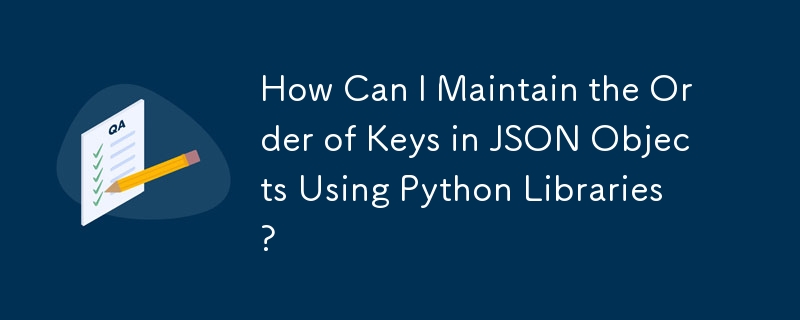
使用Python 庫保留JSON 物件屬性的順序
使用json.dumps 將Python 物件轉換為JSON 物件時,輸出字串時,輸出字串中鍵的順序可能與輸入Python 物件中鍵的原始順序不一致。如果需要特定的鍵順序,這可能會出現問題。
要解決此問題,您可以利用某些 Python 函式庫,它們提供了維護 JSON 物件中的鍵順序的工具。
使用 sort_keys 參數
一個簡單的解決方案是將 sort_keys 參數與 json.dumps 結合使用。透過將 sort_keys 設為 True,輸出 JSON 物件中的鍵將會按字母升序排序。
<code class="python">import json
json_string = json.dumps({'a': 1, 'b': 2}, sort_keys=True)
print(json_string) # Output: '{"a": 1, "b": 2}'</code>使用 collections.OrderedDict
進行更精細的控制對於按鍵順序,您可以使用 collections.OrderedDict 類別。 OrderedDict 保留鍵值對的插入順序,確保產生的 JSON 物件中的鍵順序與鍵值對新增至 OrderedDict 的順序相同。
<code class="python">from collections import OrderedDict
json_string = json.dumps(OrderedDict([('a', 1), ('b', 2)]))
print(json_string) # Output: '{"a": 1, "b": 2}'</code>保留輸入JSON 中的鍵順序
如果輸入是JSON 格式,您可以使用json.loads 中的object_pairs_hook 參數來指定將為每個鍵值對呼叫的函數JSON 物件。這允許您建立一個 OrderedDict 來保留鍵順序。
<code class="python">import json
json_string = '{"a": 1, "b": 2}'
parsed_json = json.loads(json_string, object_pairs_hook=OrderedDict)
print(parsed_json) # Output: OrderedDict([('a', 1), ('b', 2)])</code>透過利用這些技術,您可以確保 JSON 物件中的屬性順序與您所需的順序一致,從而提供更大的靈活性和控制透過 Python 中的 JSON 物件。
以上是如何使用 Python 函式庫維護 JSON 物件中鍵的順序?的詳細內容。更多資訊請關注PHP中文網其他相關文章!




